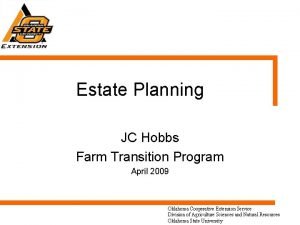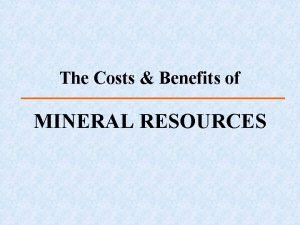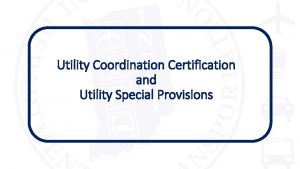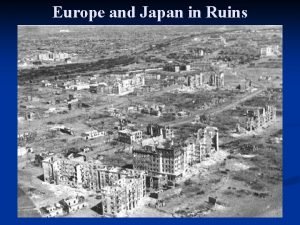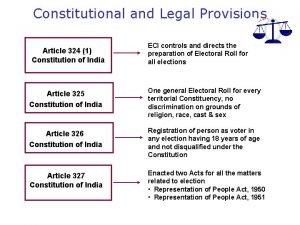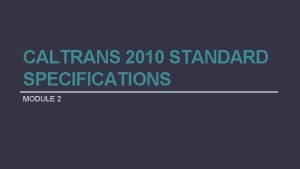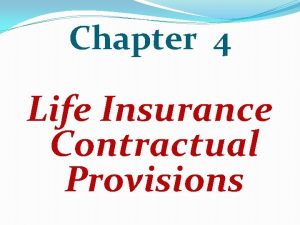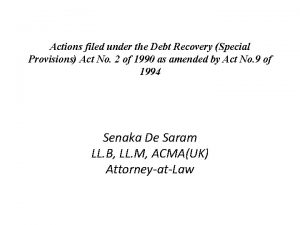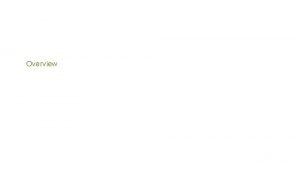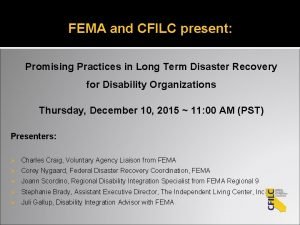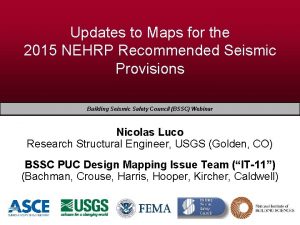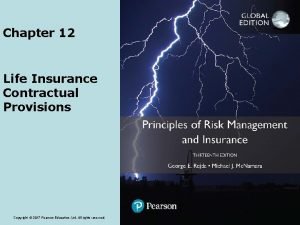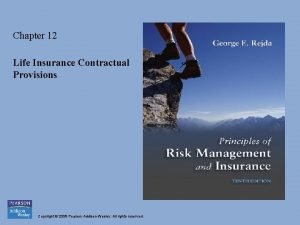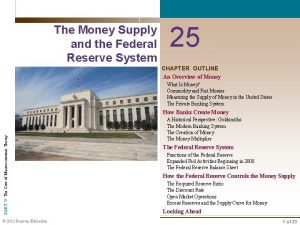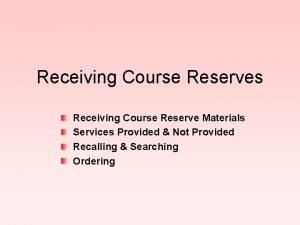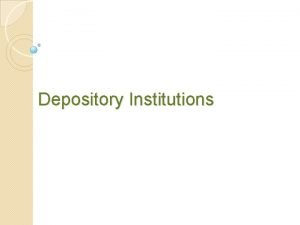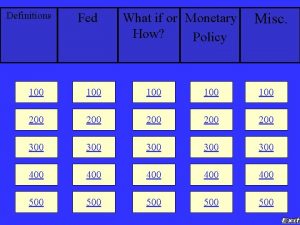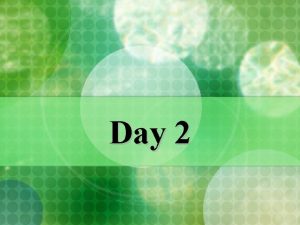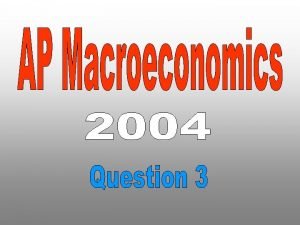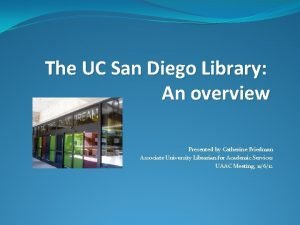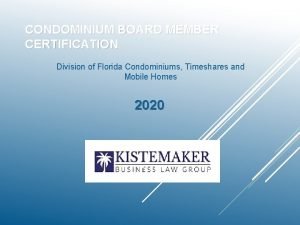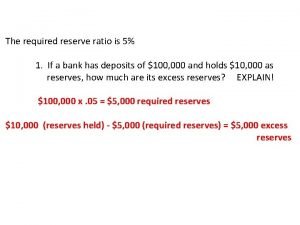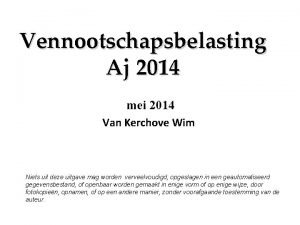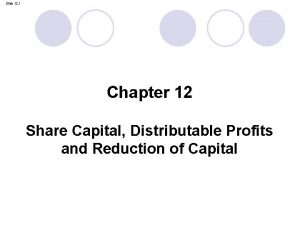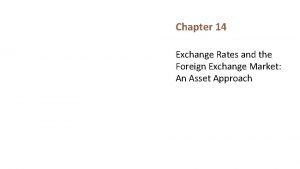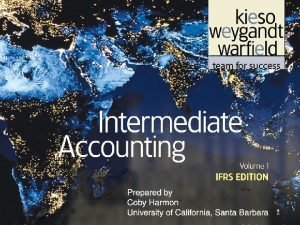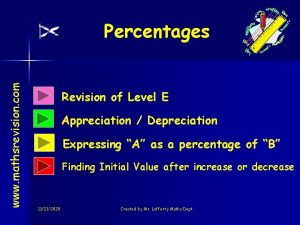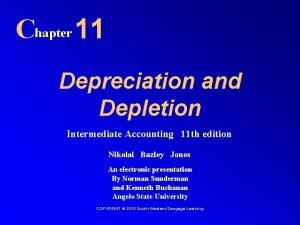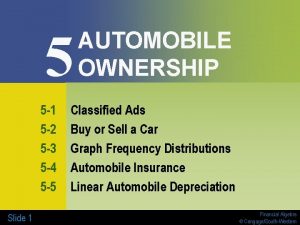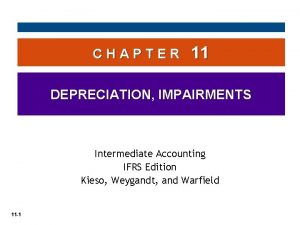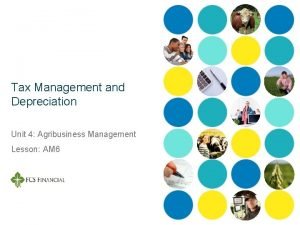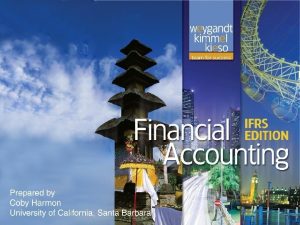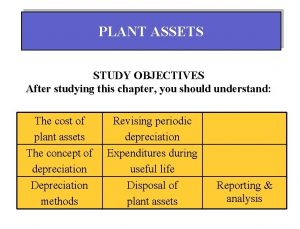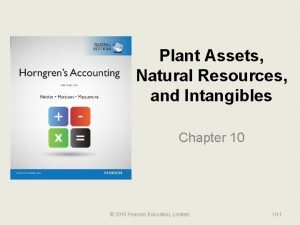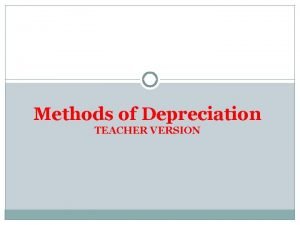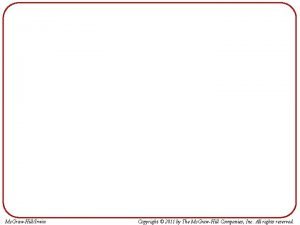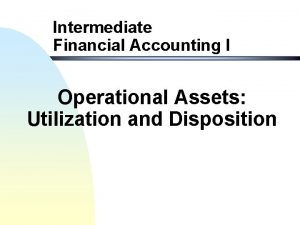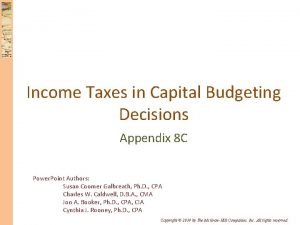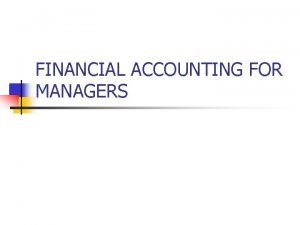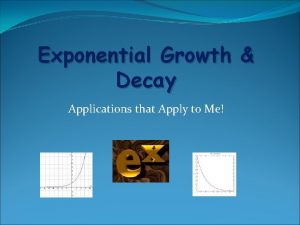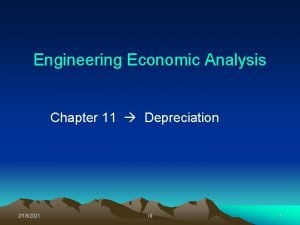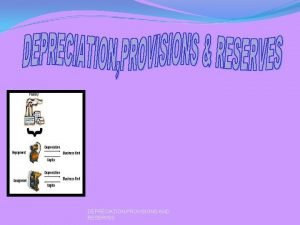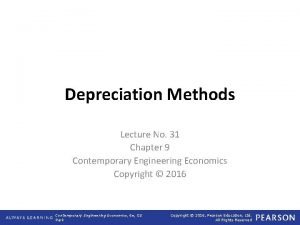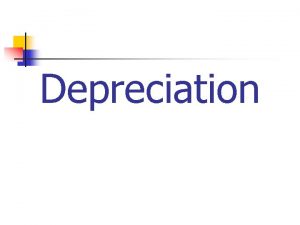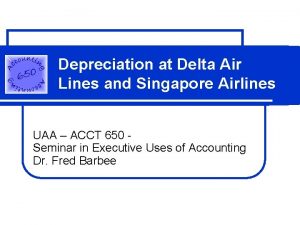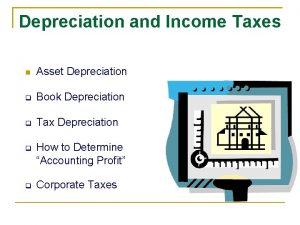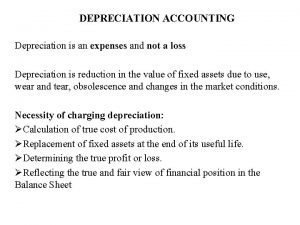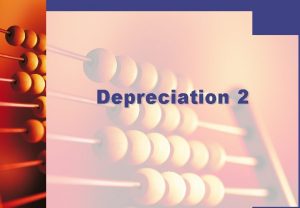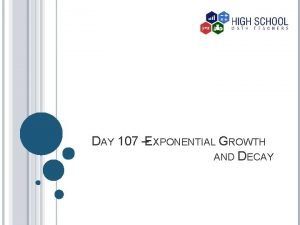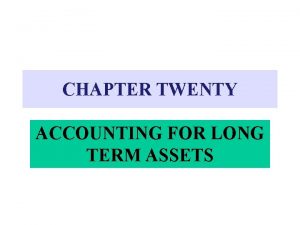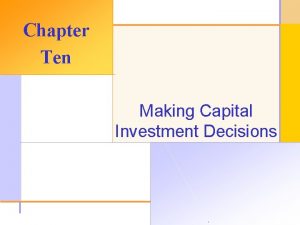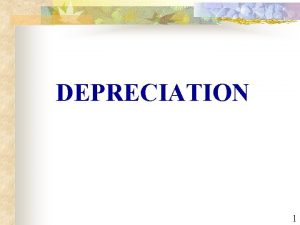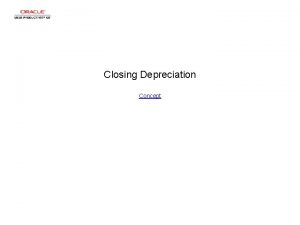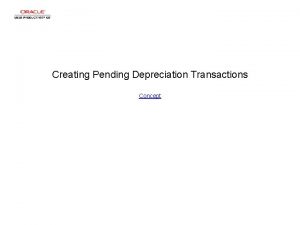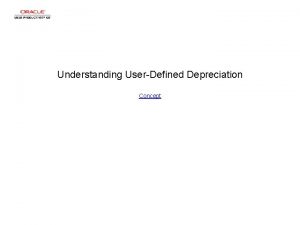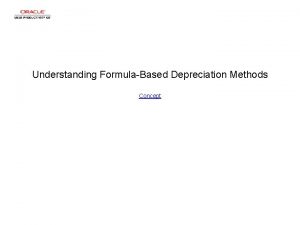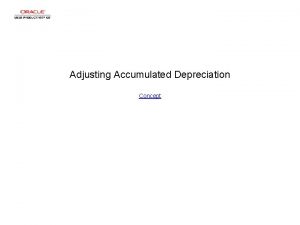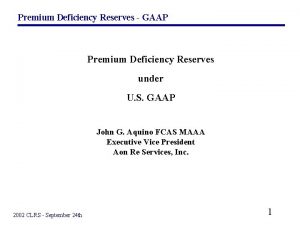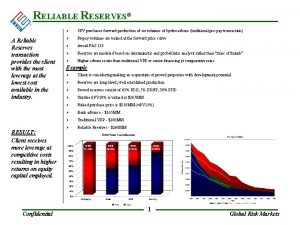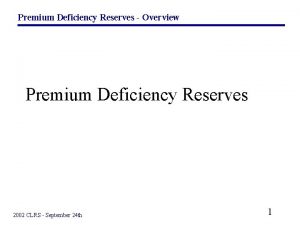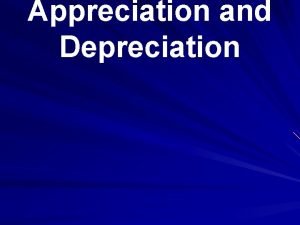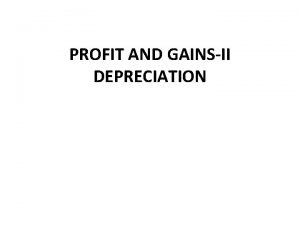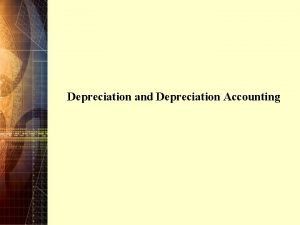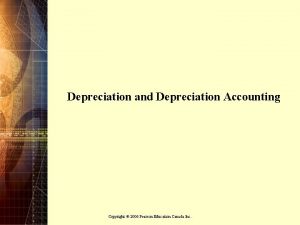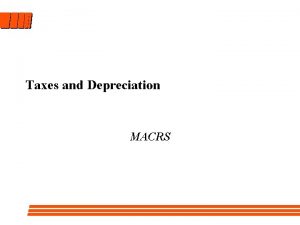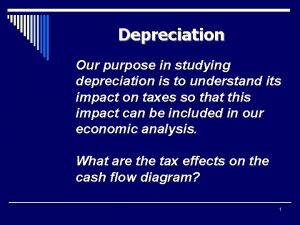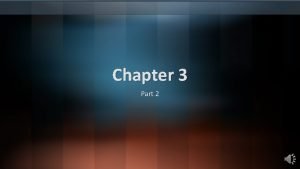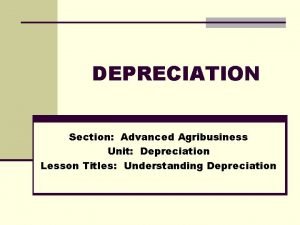DEPRECIATION PROVISIONS AND RESERVES 1 CONCEPT OF DEPRECIATION





























![Dec 31 To lease ac 25000 Dec 31 By bank [interest] 26011 813 Dec Dec 31 To lease ac 25000 Dec 31 By bank [interest] 26011 813 Dec](https://slidetodoc.com/presentation_image_h/922045d527b09eca510802731b4006fd/image-30.jpg)

















![MACHINERY ACCOUNT 2007 To bank ac [cost Ap 1 and installation charges] 100000 Dec MACHINERY ACCOUNT 2007 To bank ac [cost Ap 1 and installation charges] 100000 Dec](https://slidetodoc.com/presentation_image_h/922045d527b09eca510802731b4006fd/image-48.jpg)







![FOR REPAIRS AND RENEWALS ACCOUNT YEAR 1 To bank [Repairs] 1000 To bal cd FOR REPAIRS AND RENEWALS ACCOUNT YEAR 1 To bank [Repairs] 1000 To bal cd](https://slidetodoc.com/presentation_image_h/922045d527b09eca510802731b4006fd/image-56.jpg)
![3 To bank [Repairs] 3700 To bal cd 23000 26700 3 By bal bd 3 To bank [Repairs] 3700 To bal cd 23000 26700 3 By bal bd](https://slidetodoc.com/presentation_image_h/922045d527b09eca510802731b4006fd/image-57.jpg)


![1. Sinking fund [to replace an asset at the end of five years] To 1. Sinking fund [to replace an asset at the end of five years] To](https://slidetodoc.com/presentation_image_h/922045d527b09eca510802731b4006fd/image-60.jpg)
- Slides: 60

DEPRECIATION, PROVISIONS AND RESERVES


1 CONCEPT OF DEPRECIATION 2 CAUSES OF DEPRECIATION 3 NEED OF DEPRECIATION 4 BASIC FACTORS 5 METHODS OF DEPRECIATION 6 PROVISION AND RESERVES 24/11/2020 DEPRECIATION, PROVISIONS AND RESERVES 3

DEFINITION Depreciation is the permanent decrease in the value of an asset due to use and /or the lapse of the time. CLMA, LONDON 24/11/2020 DEPRECIATION, PROVISIONS AND RESERVES 4

CAUSES OF DEPRECIATION Physical depreciation Economic factors Time factors Depletion Accident

NEED FOR CHARGING DEPRECIATION To calculation the profit. True and fair view in balance sheet. Replacement of asset. Saving in income tax. Accurate ascertainment of cost. 24/11/2020 DEPRECIATION, PROVISIONS AND RESERVES 6

BASIC FACTORS AFFECTING DEPRECIATION Cost of asset. Estimated working life. Salvage/Residual/Scrap value. Legal provisions Additions to assets

METHODS OF DEPRECIATION CHANGE FIXED INSTALMENT MACHINE HOUR RATE DIMINISHING BALANCE DEPLETION SUM OF THE DIGITS REVALUATION ANNUITY INSURANCE POLICY DEPRECIATION FUND

STRAIGHT LINE METHOD Under this method, a fixed asset in written off annually so that, by the time asset is worn out , its proportion cost of the value in the book is reduced to zero. FORMULA FIXED ASSET- ESTIMATED SCRAP VALUE ESTIMATED LIFE OF ASSET 24/11/2020 DEPRECIATION, PROVISIONS AND RESERVES 9

MERITS AND DEMERITS 1. Simple. 2. Asset is fully written off. 3. Knowledge of total depreciation charged. 4. Suitable for fixed life assets. DEMERITS 1. Interest on capital. 2. Reairs and maintenance 3. Income tax 24/11/2020 DEPRECIATION, PROVISIONS AND RESERVES 10

QUESTION: - A trader bought machinery on 1 st jan , 2001 for Rs. 125000 whose useful life has been estimated 5 years. After the expiry of useful life , the scrap will realise Rs 25000. ANNUAL DEPRECIATION 125000 -25000 =5000 5

MACHINERY ACCOUNT DATE PARTICULARS AMT 2001 Jan 1 To bank ac DATE PARTICULA AMT RS 125000 2001 By 20000 Dec 31 depreciation ac Dec 31 By bal cd 125000 2002 Jan 1 To bal bd 105000 125000 105000 2002 By 20000 Dec 31 depreciation ac Dec 31 By bal cd 85000

105000 2003 Jan 1 To bal bd 85000 105000 2003 Dec 31 By depreciation ac 20000 Dec 31 By bal cd 65000 85000 2004 Jan 1 To bal bd 65000 85000 2004 Dec 31 By depreciation ac 20000 By bal cd 45000 65000 2005 Jan 1 To bal bd 45000 65000 2005 Dec 31 By depreciation ac 20000 Dec 31 By bal cd 25000 45000

DIMINISHING BALANCE METHOD Depreciation is calculated at a certain percentage each year on the balance of the asset which is brought forward from the previous year. The amount of depreciation charged in each period is not fixed but it goes on decreasing gradually as the beginning balance of the asset in each year will reduce.

MERITS & DEMERITS 1. Fresh calculation of depreciation are not necessary as and when additions are made. 2. this method is recognized by the income tax authorities in India. DEMERITS 1. Its difficult to determine the suitable rate of depreciation. 2. the original cost of the asset is altogether lost sight of in subsequent years and the asset can never be reduced to zero.

QUESTION: A company bought machinery for Rs. 400000, including a shaft Rs. 40000. The machinery is subject to dep at 10% by reducing instalment method. In the beginning of the fifth year , the shaft became obsolete and instalment method. In the beginning of the fifth year , the shaft become obsolete and was sold for Rs. 8000. Write up the machinery account for five years.

MACHINERY ACCOUNT DAT PARTICULARS AMT E 1 ST Yr To bank ac DATE PARTICULARS AMT 400000 1 ST Yr. By depreciation 40000 ac By bal cd 400000 2 ND Yr To bal bd 360000 2 ND Yr 360000 400000 By depreciation 36000 ac @10% ON 360000 By bal cd 324000

360000 3 RD Yr. To bal bd 324000 3 rd Yr. 360000 By depreciation@10%ON Rs. 324000 32400 By bal cd 291600 324000 4 TH Yr. To bal bd 291600 4 TH Yr. By depreciation@10%ON Rs. 291600 By bal cd 291600 29160 262440 291600 5 th Yr. To bal bd 262440 5 TH Yr. By bank ac 8000 By profit & loss [Loss on sale of shaft] 18244 By depreciation@10%ON Rs 236196 23620

By bal cd 262440 212576 262440

SUM OF THE DIGITS METHOD This is a variant of the reducing instalment or diminishing balance method.

QUESTION: -Suppose machinery was purchased for Rs. 60000 on 1 st jan, 2003 and depreciation was charged following the sum of the digits method assuming its useful life to be 3 years. Depreciation for three years will be calculated as under: DEPRECIATION FOR THE FIRST YEAR = 3 Rs. 60000 =Rs. 30000 3+2+1 SECOND YEAR = 2 Rs. 60000=Rs. 20000 6 THIRD YEAR = 1 Rs. 60000 =Rs. 10000 6

ANNUITY METHOD Under this , amount spent on purchase of an asset is regarded as an investment which is assumed to earn interest at a certain rate. The amount to be written off as depreciation is calculated from annuity table , an extract of which is given below : Years 3% 3 1% 2 4% 4 1% 2 5% 3 0. 353530 0. 359634 0. 360349 0. 363773 0. 367209 4 0. 269027 0. 272251 0. 275490 0. 278744 0. 282012 5 0. 218355 0. 221481 0. 224627 0. 227792 0. 230975

QUESTION: - A firm purchases a 5 yr lease for Rs. 40, 000 on 1 st jan. It decides to write off depreciation on annuity method , presuming the rate of interest to be 5% per annum. The annuity tables show that a sum of Rs. 9, 239 should be written off every year. Show the lease account for five yr. calculation are to be made to the nearest – rupee.

LEASE ACCOUNT DATE PARTICULARS AMT DATE PARTICULARS 1 st yr Jan 1 40000 1 st yr By depreciation 9239 Dec 31 ac 2000 Dec 31 By bal cd To cash Dec 31 To interest 42000 2 nd yr Jan 1 To bal bd Dec 31 To interest AMT 32761 42000 32761 2 nd yr By depreciation 9239 Dec 31 ac 1638 Dec 31 By bal cd 34399 25160 34399

3 rd yr Jan 1 To bal bd Dec 31 To interest 25160 3 rd yr By depreciation ac Dec 31 9239 1258 Dec 31 By bal cd 17179 26418 4 th yr Jan 1 To bal bd Dec 31 To interest 26418 17179 4 th yr By depreciation ac Dec 31 9239 859 Dec 31 By bal cd 8799 18038 5 th yr Jan 1 To bal bd Dec 31 To interest 8799 18038 5 th yr By depreciation ac Dec 31 9239 440 9239

DEPRECIATION FUND METHOD This method is implies that the amount written off as depreciation should be kept aside and invested in readily saleable securities. The securities accumulate and when the life of asset expires, the securities are sold and with the sale proceeds a new asset is purchased. The rate of interest which is easily calculated from sinking fund tables , an extract of given below :

SINKING FUND TABLE years 3% 3 1% 2 4% 4 1% 2 5% 3 0. 323540 0. 321934 0. 320349 0. 318773 0. 317208 4 0. 239027 0. 237251 0. 235490 0. 233741 0. 232012 5 0. 188350 0. 186481 0. 184627 0. 182792 0. 180975

QUESTION: - A company purchased a 3 years lease on January 1, 2007 for Rs. 25000. It is decided to provide for the replacement of lease at the end of 3 years by setting up a depreciation fund. It is expected that the investments will fetch interest at 5%. Sinking fund table show that to provide the requisite sum at 5% at the end of 3 years an investment of Rs 7932 is required every year. Investment are made to the nearest rupee. On 31 st Dec, 2009 the investments were sold for Rs. 15250. on 1 st January, 2010, the same lease was renewed for a further period of 3 years by payment of Rs. 30000.

DEPRECIATION FUND ACCOUNT 2007 To bal cd Jan 1 7932 2007 By depreciation ac 7932 Dec 31 2008 To bal cd Dec 31 16261 2008 Jan 1 By bal bd Dec 31 By bank 7932 397 Dec 31 By depreciation ac 7932 16261 2009 To depreciation Dec Fund investment 31 ac 1011 16261 2009 Jan 1 By bal bd 16261
![Dec 31 To lease ac 25000 Dec 31 By bank interest 26011 813 Dec Dec 31 To lease ac 25000 Dec 31 By bank [interest] 26011 813 Dec](https://slidetodoc.com/presentation_image_h/922045d527b09eca510802731b4006fd/image-30.jpg)
Dec 31 To lease ac 25000 Dec 31 By bank [interest] 26011 813 Dec 31 By depreciation ac 7932 Dec 31 By profit & loss ac 1005 26011

DEPRECIATION FUND INVESTMENT ACCOUNT 2007 Dec 31 To bank 7932 2007 Dec 31 By bal cd 7932 2008 jan 1 To bal bd 7932 2008 Dec 31 By bal cd 16261 Dec 31 To bank 8329 16261 2009 jan 1 To bal bd 16261 2009 Dec 31 By bank 15250 Dec 31 By depreciation fund ac [loss transferred] 1011 16261

INSURANCE POLICY METHOD This method is similar to the depreciation fund method but instead of making investment , arrangement are made with an insurance company which will receive premiums annually and pay at the end of the fixed period the required amount. Premiums have to be paid at the beginning of each year.

QUESTION: -On 1 st jan. 2006, a lease of premises is purchased for four years for Rs. 50000 and it is decided to make provision for the replacement of the lease by means of an insurance policy purchased for an annual premium of Rs. 12000. show the necessary ledger account for four years assuming that the renewal of the lease costs Rs. 50000 on 1 -1 2010.

LEASE ACCOUNT 2006 Jan 1 To bank ac 50000 2006 By bal cd dec 31 50000 2007 jan 1 To bal bd 50000 2007 By bal cd dec 31 50000 2008 jan 1 To bal bd 50000 2008 By bal cd dec 31 50000 2009 jan 1 To bal bd 50000 2009 By bal cd dec 31 50000

DEPRECIATION RESERVE ACCOUNT 2006 To bal cd Dec 31 12000 2006 By profit and Dec 31 loss ac 12000 2007 To bal cd Dec 31 24000 2007 Jan 1 12000 By bal bd Dec 31 By profit and loss ac 24000 2008 To bal cd Dec 31 12000 24000 36000 2008 Jan 1 By bal bd Dec 31 By profit and loss ac 24000 12000

36000 2009 To lease ac Dec 31 50000 36000 2009 jan 1 By bal bd 36000 Dec 31 By profit and loss 12000 ac Dec 31 By depreciation insurance policy ac [profit on the realisation of policy] 50000 2000 50000

REVALUATION METHOD Under this , the asset is revalued at the end of the accounting year and this value is compared with the value of the asset at the beginning of the year. The difference is treated as depreciation. this method is used in case of bottles, corks, crates or etc

QUSETION: - A company manufactures loose tools for its own use. At the end of each year, depreciation is charged on revaluation method. From the following particulars show the loose tools account : Year ended 31 -12 -2006 -loose tools manufactured Rs. 5000 [revalued on 31 -12 -2006: Rs. 4100]

Year ended 31 -12 -2007 -loose tools manufactured : Rs. 2700 [revalued on 31 -12 -2007: Rs 5700] Year ended 31 -12 -2008 -loose tools manufactured : Rs. 1000 [revalued on 31 -12 -2009: Rs. 6000] Year ended 3112 -2009 -loose tools manufactured : Rs. 1500 [revalued on 31 -12 -2009: Rs. 5100]

LOOSE TOOLS ACCOUNT 2006 TO COST OF PRODUCTION AC 5000 2006 BY DEP AC [Bal. fig. ] 900 BY BAL CD 4100 5000 2007 5000 TO BAL BD 4100 2007 BY DEP AC [Bal. fig. ] TO COST OF PRODUCTION AC 2700 BY BAL CD 1100 5700

6800 2008 To bal bd 5700 To cost of production ac 1000 6700 6800 2008 By depreciation ac 700 By bal cd 6000 6700 950 250 1200

DEPLETION METHOD This method is mostly used in case of mine, quarries; etc. from which certain quantity of output is expected to be obtained. The value of mine depends only upon quantity of minerals that can be obtained. when the whole quantity is taken , the mine loses its value. the rate of depreciation is worked out only so much per tonne. It is simply dividing the cost of the mine by the total quantity of the minerals expected to be available.

QUESTION: -A mine was acquired at a cost of Rs. 20, 000 on 1 st July 2007. It was expected it would yield 2, 000 tons of minerals in all. The actual output was 200710, 000 tons , 2008 -40, 000 tons and 200932, 000 tons. Write up the mine account for the above years using depletion method of charging depreciation. Rate of depreciation =Rs. 10 per ton

MINE ACCOUNT 2007 To bank ac July 1 2000000 2007 By depreciation 100000 Dec ac 31 Dec 3 By bal cd 1 2000000 2008 To bal bd Jan 1 1900000 2000000 1900000 2008 By depreciation 400000 Dec 3 ac 1 Dec 3 By bal cd 1 15000000

1900000 2009 To bal bd Jan 1 1900000 1500000 2009 By depreciation 320000 Dec 31 ac Dec 31 By bal cd 1500000 2010 Jan 1 To bal bd 1180000 1500000

MACHINE HOUR RATE METHOD This method is useful in case of machines. The life of machine is fixed in terms of hours. Hourly rate of depreciation is worked out by dividing the cost of the machine by the total number of hours for which the machine is expected to be used. depreciation to be written off in a year will be ascertained by multiplying the hourly rate of depreciation by the number of hours that the machine actually runs in the year.

QUESTION: - A machine was acquired on 1 st April, 2008 at a cost of Rs 90, 000, the cost of installation being Rs. 10000. It is expected that its total life will be 20, 000 hours. During 2008 it worked for 5, 000 hours and during 2009 for 8, 000 hours. Write up the machinery account for 2008 & 2009. Machine hour rate= Rs 5 per hour
![MACHINERY ACCOUNT 2007 To bank ac cost Ap 1 and installation charges 100000 Dec MACHINERY ACCOUNT 2007 To bank ac [cost Ap 1 and installation charges] 100000 Dec](https://slidetodoc.com/presentation_image_h/922045d527b09eca510802731b4006fd/image-48.jpg)
MACHINERY ACCOUNT 2007 To bank ac [cost Ap 1 and installation charges] 100000 Dec 31 By depreciation ac Dec 31 By bal cd 100000 2009 To bal bd Jan 1 75000 2010 To bal bd Jan 1 35000 25000 75000 100000 2009 Dec 31 By depreciation ac 40000 Dec 31 By bal cd 35000 75000

CHANGE OF METHOD Sometimes the method is changed either from straight line method to diminishing balance method or from diminishing balance method to straight line method with effect from the current year or with retrospective effect. if the change is from current year then there will be no problem but simply to change the method of depreciation.

QUESTION: - Plant and machinery account of a company had a debit balance of Rs. 1, 47, 390 on 1 st jan , 2009. The company was incorporated in 2006 and has been following the practice of charging full year, depreciation every year on diminishing balance system @15%. In 2009 it was, however decided to change the method from reducing system to straight line with retrospection effect from 2006 and to give effect of the change while preparing the final accounts for the year ended 31 st dec, 2009, the rate of depreciation remaining same as before. In 2009, new machineries were purchased at a cost of Rs. 50, 000. All the other machineries were acquired in 2006. Show Plant and machinery account from 2006 to 2009.

PLANT AND MACHINERY ACCOUNT 2006 TO BANK AC Jan 1 240000 2006 BY DEP AC Dec 31 [15% on Rs 240000] Dec 31 BY BALCD 2007 TO BAL BD Jan 1 36000 204000 240000 204000 2007 BY DEP AC Dec 31 [15% on Rs 204000 30600 Dec 31 BY BAL CD 173400

204000 2008 To bal bd Jan 1 173400 204000 2008 By depreciation ac 26010 Dec [15% on Rs 173400 31 Dec 31 By bal cd 173400 147390 173400 2009 To bal bd Jan 1 147390 2009 By profit and Dec loss ac 31 [additional dep] 2 15390 Jan 1 To bank ac [Additions] 50000 Dec 31 By depreciation ac 43500 [15%on 240000+50000]

Dec 31 By bal cd 197390 138500 197390

PROVISIONS AND RESERVES MEANING OF PROVISIONS The term “provision” means any amount written off or retained by way of providing depreciation , renewals or diminution in the value of assets or retained by way of providing for any know liability the amount of which may not be determined with substantial accuracy

Question: - A firm desires to debit its profit and loss account with a uniform figure every year in respect of repairs and renewals. It expects that considering the life of the asset in question Rs. 10, 000 will be the average amount to spent per year. Actual repairs are Rs. 1, 000 in the first year, Rs. 2, 300 in the second year and Rs. 3, 700 in the third year. Show the provision for repairs and renewals account.
![FOR REPAIRS AND RENEWALS ACCOUNT YEAR 1 To bank Repairs 1000 To bal cd FOR REPAIRS AND RENEWALS ACCOUNT YEAR 1 To bank [Repairs] 1000 To bal cd](https://slidetodoc.com/presentation_image_h/922045d527b09eca510802731b4006fd/image-56.jpg)
FOR REPAIRS AND RENEWALS ACCOUNT YEAR 1 To bank [Repairs] 1000 To bal cd 9000 YEAR By profit and 10000 1 loss ac 10000 2 10000 To bank [Repairs] 2300 2 By bal bd 9000 To bal cd 16700 By profit and 10000 loss ac 19000
![3 To bank Repairs 3700 To bal cd 23000 26700 3 By bal bd 3 To bank [Repairs] 3700 To bal cd 23000 26700 3 By bal bd](https://slidetodoc.com/presentation_image_h/922045d527b09eca510802731b4006fd/image-57.jpg)
3 To bank [Repairs] 3700 To bal cd 23000 26700 3 By bal bd 16700 By profit and loss ac 10000 26700

MEANING OF RESERVE Any sum which is appropriated out of profit and loss appropriation account and is not meant to cover up liability, contingency, commitment, or reduction in the value of an asset is a reserve.

QUESTION: - Show the distinction between sinking fund to repay a liability and sinking fund to replace a wasting asset by the operation of ledger account at the end of five years in the following cases: 1. sinking fund to replace leasehold property valued Rs. 900000 at the end of five years. 2. sinking fund to repay Rs. 900000 debentures at the end of five years.
![1 Sinking fund to replace an asset at the end of five years To 1. Sinking fund [to replace an asset at the end of five years] To](https://slidetodoc.com/presentation_image_h/922045d527b09eca510802731b4006fd/image-60.jpg)
1. Sinking fund [to replace an asset at the end of five years] To old lease ac [transfer] 900000 By bal bd 900000 OLD LEASE ACCOUNT To bal bd 900000 By sinking fund ac [transfer] 900000 NEW LEASE ACCOUNT To bank ac 900000 2. Sinking fund [to repay a liability at the end of five years] To reserve fund [transfer] 900000 By bal bd 900000 DEBENTURES ACCOUNT To bank ac 900000 By bal bd 900000
 New hobbs farm and provisions
New hobbs farm and provisions Recyclingmineral
Recyclingmineral Indot unique special provisions
Indot unique special provisions Ruins provisions
Ruins provisions Legal provisions
Legal provisions Caltrans revised standard specifications
Caltrans revised standard specifications Life insurance contractual provisions
Life insurance contractual provisions Debt recovery special provisions act
Debt recovery special provisions act Fidelity personal trust
Fidelity personal trust Provisions of fema act 1999
Provisions of fema act 1999 2015 nehrp recommended seismic provisions
2015 nehrp recommended seismic provisions Common provisions regulation
Common provisions regulation Life insurance contractual provisions
Life insurance contractual provisions Life insurance contractual provisions
Life insurance contractual provisions How to find required reserves
How to find required reserves Course reserves ucsb
Course reserves ucsb Reserves of depository institutions
Reserves of depository institutions How to find excess reserves
How to find excess reserves How to find excess reserves
How to find excess reserves Formula of money multiplier
Formula of money multiplier Biosphere reserves in world
Biosphere reserves in world How to calculate excess reserves
How to calculate excess reserves Ucsd course reserves
Ucsd course reserves Thorium reserves in world
Thorium reserves in world Florida board member certification course
Florida board member certification course Zoned reserves
Zoned reserves Require reserve ratio
Require reserve ratio Kapitaalvermindering vastgeklikte reserves
Kapitaalvermindering vastgeklikte reserves Share premium distributable reserves
Share premium distributable reserves Ideal self real self and actual self
Ideal self real self and actual self Perbedaan selling concept dan marketing concept
Perbedaan selling concept dan marketing concept Appreciation and depreciation of currency
Appreciation and depreciation of currency Component depreciation
Component depreciation Www.mathsrevision.com
Www.mathsrevision.com Chapter 11 depreciation
Chapter 11 depreciation 5-6 historical and exponential depreciation answers
5-6 historical and exponential depreciation answers Chapter 11 depreciation impairments and depletion
Chapter 11 depreciation impairments and depletion How to calculate depreciation
How to calculate depreciation Units-of-activity method of depreciation
Units-of-activity method of depreciation Double decline balance method formula
Double decline balance method formula Depreciation straight line method
Depreciation straight line method Isolux diagram for finding luminance on road surface is a
Isolux diagram for finding luminance on road surface is a Double declining method depreciation
Double declining method depreciation Double declining method depreciation
Double declining method depreciation Activity based method depreciation
Activity based method depreciation Depreciation tax shield in capital budgeting
Depreciation tax shield in capital budgeting Deemed depreciation fbt
Deemed depreciation fbt Accumulated depreciation journal entry
Accumulated depreciation journal entry Accounting definition
Accounting definition Exponential decay car depreciation worksheet
Exponential decay car depreciation worksheet Soyd depreciation
Soyd depreciation Machine hour method of depreciation
Machine hour method of depreciation Macrs depreciation formula
Macrs depreciation formula Capital expenditures in accounting
Capital expenditures in accounting Singapore air lines
Singapore air lines Depreciation recapture
Depreciation recapture Depreciation in accounting
Depreciation in accounting Provision of depreciation account
Provision of depreciation account Exponential decay function
Exponential decay function Other long term assets
Other long term assets Chapter 10 making capital investment decisions
Chapter 10 making capital investment decisions
